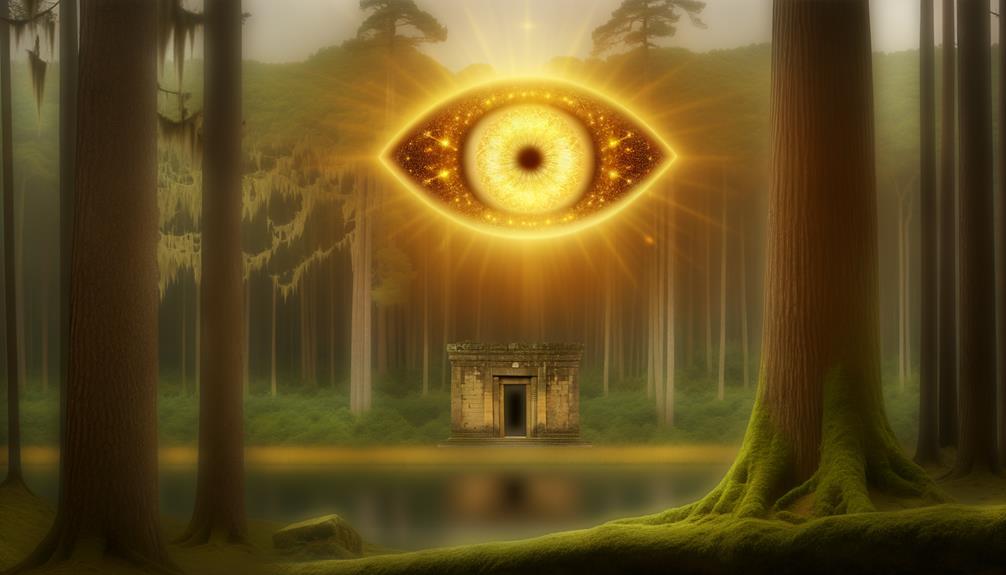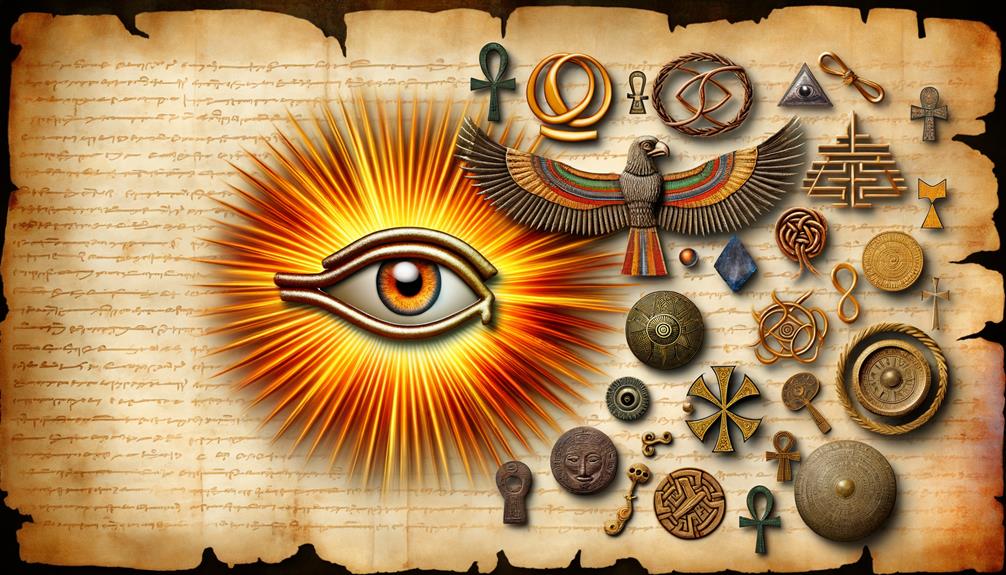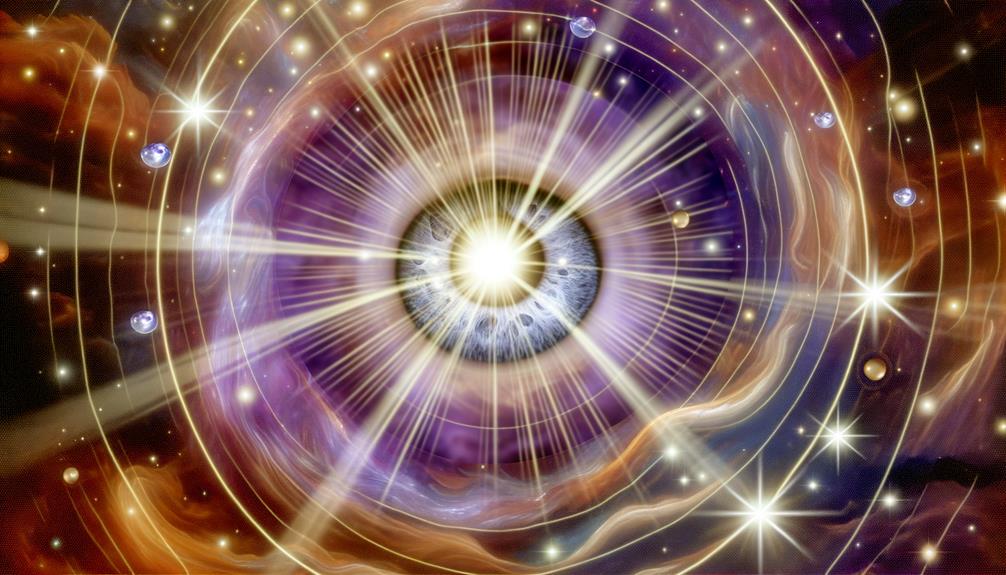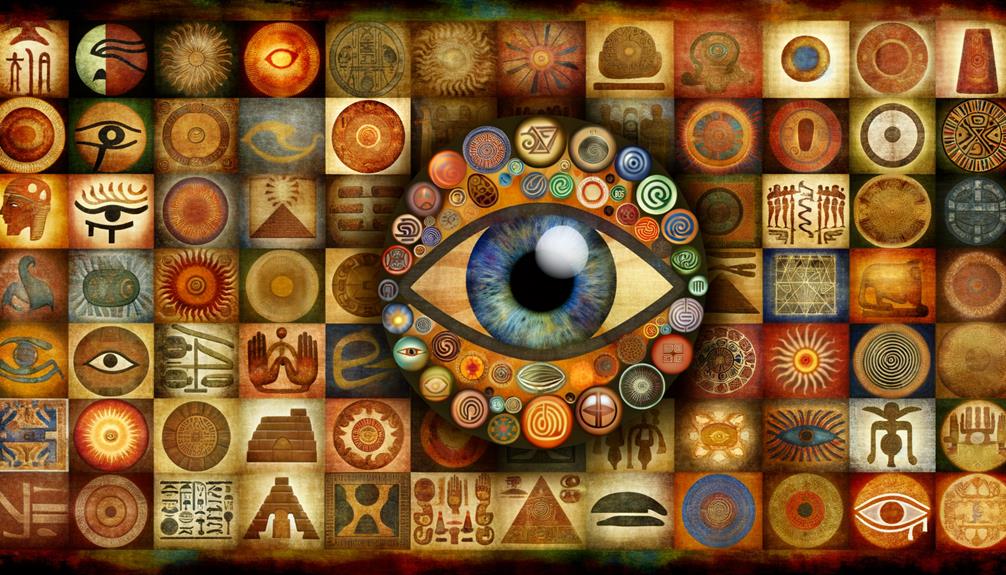The Eye of Providence Spiritual Meaning: Divine Guidance
The Eye of Providence, symbolizing divine omniscience and enlightenment, has profound spiritual significance across various cultures. Rooted in ancient Egyptian and Greco-Roman traditions, it represents protection and foresight.
In Christianity, the eye within a triangle reflects the Holy Trinity and God’s all-seeing nature, while in Freemasonry, it serves as a reminder of a higher power’s vigilant presence, enforcing ethical conduct. Renaissance art prominently features the symbol, emphasizing divine guidance, which continues to influence modern interpretations.
Consequently, the Eye of Providence encapsulates humanity’s quest for understanding the divine, and further exploration reveals its intricate symbolism and enduring relevance.

The Eye of Providence Spiritual Meaning: Divine Watchfulness and Enlightenment
| Symbolism | Meaning |
|---|---|
| Divine Watchfulness | Represents God’s or the Universe’s omnipresent awareness |
| Spiritual Enlightenment | Symbol of awakening, inner vision, and higher consciousness |
| Protection and Guidance | Offers reassurance of divine support and direction |
| Universal Truth | Reflects the all-seeing eye’s connection to absolute truth and justice |
| Inner Knowing | Encourages trust in intuition and inner spiritual insight |
Historical Origins

Tracing back to ancient civilizations, the historical origins of the Eye of Providence reveal a rich tapestry of symbolic interpretations and cultural significance.
This iconic emblem, often depicted as an eye within a triangle, is rooted in ancient Egyptian iconography, particularly the Eye of Horus, symbolizing protection, royal power, and good health.
Additionally, it appears in later Greco-Roman traditions, where it represented divine omniscience and foresight. The concept was further perpetuated through Renaissance art, where it began to merge with Christian iconography.
The Eye of Providence consequently evolved from a multifaceted emblem of divine presence and protection into a widely recognized symbol.
Its enduring legacy underscores humanity’s universal quest to conceptualize the divine and the unseen forces governing existence.
Symbolism in Christianity
Within the context of Christianity, the Eye of Providence is often regarded as an emblem of divine omniscience, encapsulating the belief in God’s all-seeing nature and perpetual vigilance over creation.
This symbol, commonly depicted as an eye enclosed within a triangle and radiating light, serves as a powerful reminder of God’s omnipresence and judgment. The triangle represents the Holy Trinity—Father, Son, and Holy Spirit—while the eye signifies God’s ability to see all, guiding and protecting the faithful.
| Symbol Element | Christian Interpretation |
|---|---|
| Eye | Divine Omniscience |
| Triangle | Holy Trinity |
| Light Rays | God’s Glory and Enlightenment |
| Central Placement | God’s Central Role in Creation |
| Enclosure | Unity and Wholeness in God |
This symbolism embodies the theological affirmation of God’s intimate involvement in the cosmos.
Influence in Freemasonry

The Eye of Providence, while deeply rooted in Christian symbology, also holds significant esoteric and philosophical importance within the traditions of Freemasonry.
In Masonic iconography, the Eye is often depicted within a triangle, symbolizing the all-seeing eye of the Great Architect of the Universe. This representation serves as a reminder of the ever-watchful presence of a higher power, overseeing the moral and ethical conduct of its members.
Freemasonry, with its emphasis on enlightenment, secrecy, and the pursuit of moral virtue, adopts the Eye of Providence to reinforce the idea of internal vigilance and self-awareness. The symbol underscores the belief in a guiding divine presence, fostering a sense of accountability and integrity among the brethren.
Representation in Art
The Eye of Providence has made significant appearances in artistic representations, particularly within Renaissance art, where it often symbolized divine omniscience and guidance.
This motif has continued to influence modern artists, who reinterpret its spiritual connotations to reflect contemporary themes.
Additionally, numerous paintings embed the Eye of Providence with hidden meanings, encouraging viewers to explore layered narratives and esoteric symbolism.
Symbolism in Renaissance Art
Renaissance art frequently employs the Eye of Providence to convey complex theological and philosophical themes, embedding this symbol within intricate compositions to evoke divine omniscience and guidance.
Artists such as Leonardo da Vinci and Albrecht Dürer adeptly integrated the Eye within their works, often surrounded by a radiant triangle, which symbolized the Holy Trinity.
This visual representation not only asserted the divine nature of creation but also emphasized the moral and spiritual oversight of a higher power.
Paintings and frescoes from this era often placed the Eye of Providence in central or elevated positions, reinforcing its role as a watchful, guiding force.
Consequently, the symbol served as a profound reminder of humanity’s connection to the divine.
Influence on Modern Artists
Modern artists have reinterpreted the Eye of Providence, infusing it with contemporary meanings while maintaining its historical connotations of vigilance and divine insight. This symbol has been adapted in various media, from painting and sculpture to digital art, reflecting modern societal concerns such as surveillance, spirituality, and the quest for higher knowledge.
Artists like Alex Grey and Shepard Fairey incorporate the Eye of Providence to explore themes of consciousness and political critique. Grey’s visionary art often utilizes the Eye to signify enlightenment and interconnectedness, while Fairey employs it to comment on power structures and social justice.
These reinterpretations preserve the symbol’s essence while expanding its relevance in today’s cultural and artistic discourse.
Hidden Meanings in Paintings
Building on the reinterpretations by contemporary artists, the Eye of Providence‘s hidden meanings in paintings reveal a complex interplay between symbolism and artistic expression, often imbuing works with layers of esoteric significance and cultural commentary.
This enigmatic symbol, frequently positioned within a triangle, transcends its overt association with divine oversight to embody themes of enlightenment, omniscience, and societal power structures.
Artists leverage this icon to critique political authority, explore metaphysical ideas, and evoke introspection.
For instance, in surrealist and abstract movements, the Eye of Providence can be discerned as a focal point that challenges viewers to question their perceptions, beliefs, and the nature of reality itself, thereby enriching the visual narrative with profound, often elusive, meanings.
Connection to Enlightenment

The Eye of Providence is often interpreted as a symbol of illumination, representing the acquisition of esoteric knowledge and spiritual insight.
This emblem serves as a guiding force on the pathway to awakening, encouraging individuals to transcend mundane perceptions and attain higher levels of consciousness.
Through its association with divine omniscience, the Eye underscores the transformative journey towards enlightenment.
Symbolism of Illumination
In the domain of spiritual symbolism, the Eye of Providence is often interpreted as a representation of illumination and enlightenment, signifying the presence of divine insight and wisdom.
This emblem, frequently depicted within a radiant triangle, encapsulates the notion of spiritual awakening and the attainment of higher knowledge.
The rays of light emanating from the eye symbolize the dissemination of divine truth and the dispelling of ignorance.
By illuminating the path toward understanding, the Eye of Providence serves as a beacon for seekers of spiritual wisdom, guiding them toward a more profound, enlightened state.
This symbolism underscores the transformative power of divine perception, highlighting its role in elevating human consciousness and fostering a deeper connection with the transcendent.
Pathway to Awakening
A critical aspect of the Eye of Providence‘s spiritual significance lies in its role as a conduit for individuals on their journey toward enlightenment, facilitating the change from ignorance to profound spiritual awareness.
This emblem, often depicted as an all-seeing eye within a triangle, serves as a metaphorical guidepost, illuminating the path of self-realization and inner wisdom.
It symbolizes the awakening of the inner consciousness, encouraging seekers to transcend mundane perceptions and attain higher states of spiritual insight.
Modern Interpretations
Emerging in contemporary culture, the Eye of Providence has been reinterpreted through various lenses, reflecting diverse philosophical, artistic, and social paradigms.
Philosophically, it is often seen as a metaphor for enlightenment and self-awareness, symbolizing the pursuit of truth and the quest for higher consciousness.
Artists leverage the symbol to comment on themes of surveillance and the omnipresence of technology, infusing it with modern anxieties about privacy and control.
Socially, the Eye of Providence is employed in popular media and subcultures to signify an awareness of hidden truths and conspiratorial thinking.
These reinterpretations underscore the symbol’s evolving nature, adapting its traditional spiritual connotations to address contemporary issues and collective consciousness.
Cultural Variations

Across different civilizations and historical periods, the Eye of Providence has been imbued with unique cultural significance, reflecting the distinct religious, philosophical, and social contexts of each era. Importantly, the symbol’s interpretation varies widely, from ancient Egyptian theology to Renaissance Christian iconography.
| Culture | Significance |
|---|---|
| Ancient Egypt | The Eye of Horus, symbolizing protection and royal power. |
| Christianity | Representation of the Holy Trinity and divine omniscience. |
| Freemasonry | Emblem of the watchful eye of the Great Architect of the Universe. |
Each cultural context offers a distinct lens through which the Eye of Providence is understood, highlighting the adaptability and depth of this enduring symbol. These variations underscore the symbol’s capacity to convey profound spiritual and existential themes across diverse traditions.
Symbol in Popular Media
The Eye of Providence has permeated popular media, serving as a potent symbol in films, television series, literature, and digital platforms, often embodying themes of surveillance, omnipotence, and hidden knowledge. Its recurrent appearance underscores its multifaceted implications:
- Films: In movies like ‘National Treasure,’ the Eye of Providence is depicted as a clue to uncovering hidden truths, linking it to themes of mystery and revelation.
- Television Series: Shows such as ‘The Simpsons’ and ‘Mr. Robot’ utilize the symbol to critique societal issues related to surveillance and control.
- Literature: In literary works, authors frequently embed the symbol to evoke notions of divine oversight or clandestine operations, enriching narratives with layers of meaning.
Such portrayals highlight the symbol’s enduring relevance and adaptability in contemporary storytelling.
Personal Spiritual Significance

For many individuals, the Eye of Providence holds profound personal spiritual significance, symbolizing a connection to the divine and an awareness of a higher power overseeing their lives.
This emblem often represents an omniscient presence that provides comfort, guidance, and protection. In personal spiritual practices, the Eye of Providence can serve as a focal point for meditation, fostering a sense of inner peace and heightened consciousness.
Its depiction as an all-seeing eye underscores notions of moral integrity and ethical responsibility, urging individuals to align their actions with universal principles.
Consequently, the symbol becomes a powerful reminder of one’s spiritual journey, encouraging continuous self-reflection and growth within the broader tapestry of divine orchestration.
Conclusion
The Eye of Providence, deeply rooted in history and symbolism, transcends mere artistic representation to embody profound spiritual and philosophical concepts.
Its pervasive presence in Christianity, Freemasonry, and Enlightenment thought, alongside its varied cultural interpretations, invites contemplation.
As modern interpretations evolve and its image permeates popular media, one must ponder: does this ancient emblem continue to hold intrinsic spiritual significance, or has it merely become a relic of esoteric tradition, shrouded in the mysteries of the past?






